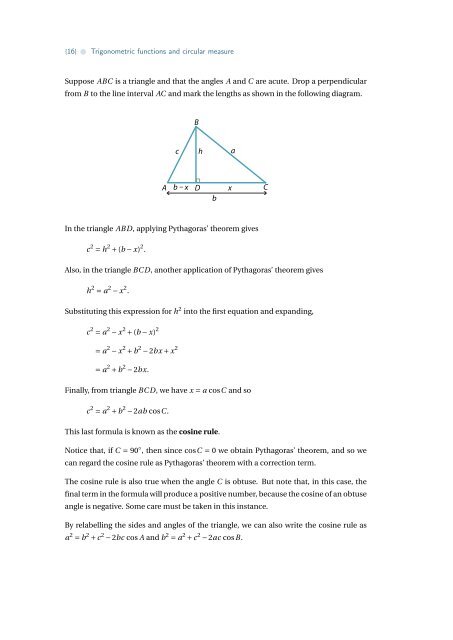Trigonometric functions and circular measure - the Australian ...
Trigonometric functions and circular measure - the Australian ...
Trigonometric functions and circular measure - the Australian ...
- No tags were found...
You also want an ePaper? Increase the reach of your titles
YUMPU automatically turns print PDFs into web optimized ePapers that Google loves.
{16} • <strong>Trigonometric</strong> <strong>functions</strong> <strong>and</strong> <strong>circular</strong> <strong>measure</strong>Suppose ABC is a triangle <strong>and</strong> that <strong>the</strong> angles A <strong>and</strong> C are acute. Drop a perpendicularfrom B to <strong>the</strong> line interval AC <strong>and</strong> mark <strong>the</strong> lengths as shown in <strong>the</strong> following diagram.BchaAb – xDbxCIn <strong>the</strong> triangle ABD, applying Pythagoras’ <strong>the</strong>orem givesc 2 = h 2 + (b − x) 2 .Also, in <strong>the</strong> triangle BC D, ano<strong>the</strong>r application of Pythagoras’ <strong>the</strong>orem givesh 2 = a 2 − x 2 .Substituting this expression for h 2 into <strong>the</strong> first equation <strong>and</strong> exp<strong>and</strong>ing,c 2 = a 2 − x 2 + (b − x) 2= a 2 − x 2 + b 2 − 2bx + x 2= a 2 + b 2 − 2bx.Finally, from triangle BC D, we have x = a cosC <strong>and</strong> soc 2 = a 2 + b 2 − 2ab cosC .This last formula is known as <strong>the</strong> cosine rule.Notice that, if C = 90 ◦ , <strong>the</strong>n since cosC = 0 we obtain Pythagoras’ <strong>the</strong>orem, <strong>and</strong> so wecan regard <strong>the</strong> cosine rule as Pythagoras’ <strong>the</strong>orem with a correction term.The cosine rule is also true when <strong>the</strong> angle C is obtuse. But note that, in this case, <strong>the</strong>final term in <strong>the</strong> formula will produce a positive number, because <strong>the</strong> cosine of an obtuseangle is negative. Some care must be taken in this instance.By relabelling <strong>the</strong> sides <strong>and</strong> angles of <strong>the</strong> triangle, we can also write <strong>the</strong> cosine rule asa 2 = b 2 + c 2 − 2bc cos A <strong>and</strong> b 2 = a 2 + c 2 − 2ac cosB.
















